15 KPIs for Sales You Need To Track for Your Small Business
15 KPIs for Sales You Need To Track for Your Small Business

In today's fast-paced business landscape, staying ahead of the competition and achieving sales success requires a data-driven approach. As a small business owner, having a clear understanding of your sales performance is crucial for making informed decisions and driving growth. This is where key performance indicators (KPIs) for sales come into play.
In this post, we’ll delve into everything you need to know about sales KPIs and explore the top 15 metrics every small business owner should be tracking. By monitoring these metrics, you can gain a comprehensive understanding of your sales performance, identify areas for improvement, and strategically align your efforts to achieve optimal results.
What are KPIs in sales?
KPIs in sales are quantifiable metrics that measure the performance and effectiveness of sales activities and processes. These metrics serve as benchmarks for evaluating sales performance, identifying areas for improvement, and making informed decisions to optimize sales strategies.
KPIs in sales vary depending on various factors, such as the nature of your business, the industry you operate in, and your overall business goals.
For example, SaaS businesses may value KPIs like monthly recurring revenue (MRR), which measures the predictable and recurring revenue generated from subscription-based services each month. Those in retail may value their average transaction value (ATV), which indicates the average amount customers spend per store visit.
By tracking and analyzing your KPIs, you can gain valuable insights into your sales performance, identify trends, assess the impact of sales initiatives, and make data-driven adjustments to drive growth and improve overall sales effectiveness.

Why are KPIs important?
KPIs in sales are essential tools for effectively managing and optimizing business performance. Here are just a few reasons why sales KPIs are important to track and measure:
- Performance measurement: KPIs provide a quantifiable way to measure the performance of reps, teams, and your overall business. They help gauge progress and identify areas of strength or areas that need improvement.
- Goal alignment: KPIs serve as a tool to align business goals with day-to-day activities. They help ensure everyone is working toward the same goals. They should always use the SMART criteria.
- Focus and prioritization: KPIs help prioritize efforts by highlighting the most critical areas that require attention. They help teams focus on activities that have the greatest impact on desired outcomes.
- Decision-making: KPIs provide meaningful data that inform decision-making processes. They provide insights into trends, patterns, and performance drivers, enabling informed and data-driven decision-making.
- Accountability and transparency: KPIs create a sense of accountability within your business. When reps and teams have clear targets and ways to measure their progress, it fosters a culture of ownership, responsibility, and transparency.
- Continuous improvement: KPIs help you identify areas for improvement and set performance benchmarks. Monitoring KPIs over time allows you to track progress, set new targets, and continuously strive for better results.
15 sales KPIs to track for your small business
The KPIs you choose will vary based on your business's specific needs and objectives. Nevertheless, a few sales KPIs can be relevant to almost any small business. Here is a list of 15 sales KPIs you should consider tracking.

1. Monthly sales growth
Monthly sales growth provides insights into your sales performance on a month-to-month basis. It helps assess the effectiveness of your sales strategies and initiatives in the short term and helps identify if you’re gaining or losing ground.
What it measures: the percentage increase or decrease in sales revenue over a specific month
Why it’s important: Tracking monthly sales growth allows you to identify trends, make informed decisions, set targets, and evaluate sales success over time. Comparing growth rates across different periods helps you gain insight into campaign effectiveness, market changes, and customer preferences.

2. Average profit margin
Your average profit margin provides insights into how efficiently your business is generating profit from its operations.
What it measures: the proportion of total sales revenue that translates into profits
Why it’s important: Average profit margin helps assess how effectively you’re controlling costs, pricing, and overall profitability. By comparing your average profit margin to industry benchmarks or historical data, you’ll gain insight into your business’s performance relative to your competitors and your own past performance.
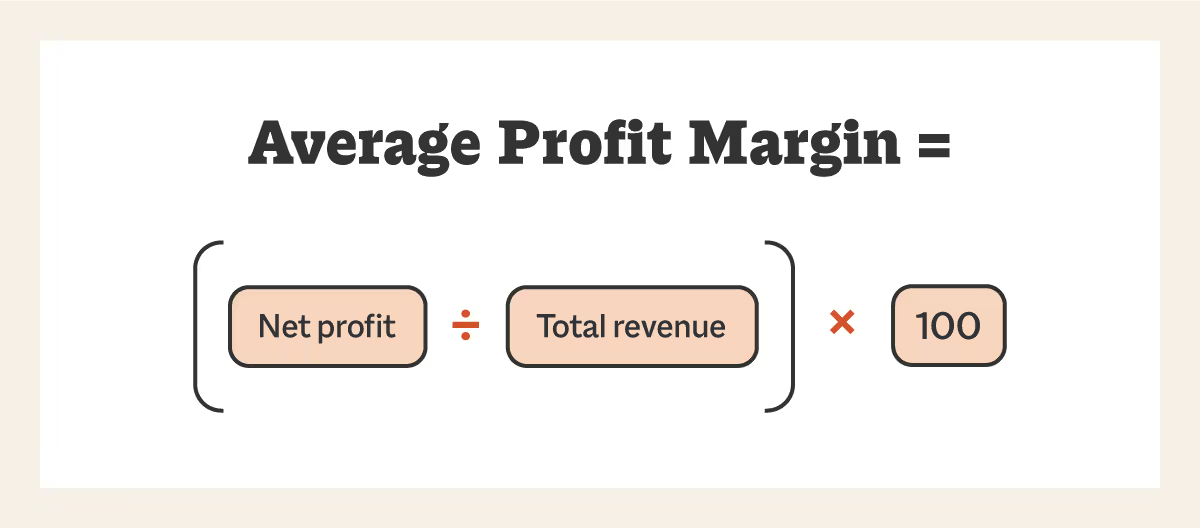
3. Customer acquisition cost (CAC)
CAC helps you understand the costs required to attract and convert new customers, including costs tied to advertising, promotions, salaries, commissions, and overhead expenses.
What it measures: the average cost a business incurs to acquire a new customer
Why it’s important: By calculating your CAC, you can evaluate the efficiency and effectiveness of your customer acquisition strategies. The lower your CAC, the more cost-effective your sales and marketing strategies are.

4. Customer lifetime value (CLV)
Customer lifetime value is an essential metric to help you understand how valuable a customer is to your business.
What it measures: the projected total revenue a customer is expected to generate throughout their lifelong relationship with a business
Why it’s important: Understanding CLV is essential for making informed decisions about customer acquisition, retention, and overall business strategy. It can help you allocate resources effectively, identify high-value customers, and develop personalized marketing and retention strategies. Comparing CLV with CAC helps determine the profitability of customer acquisition efforts and allows you to optimize your marketing and sales strategies accordingly.
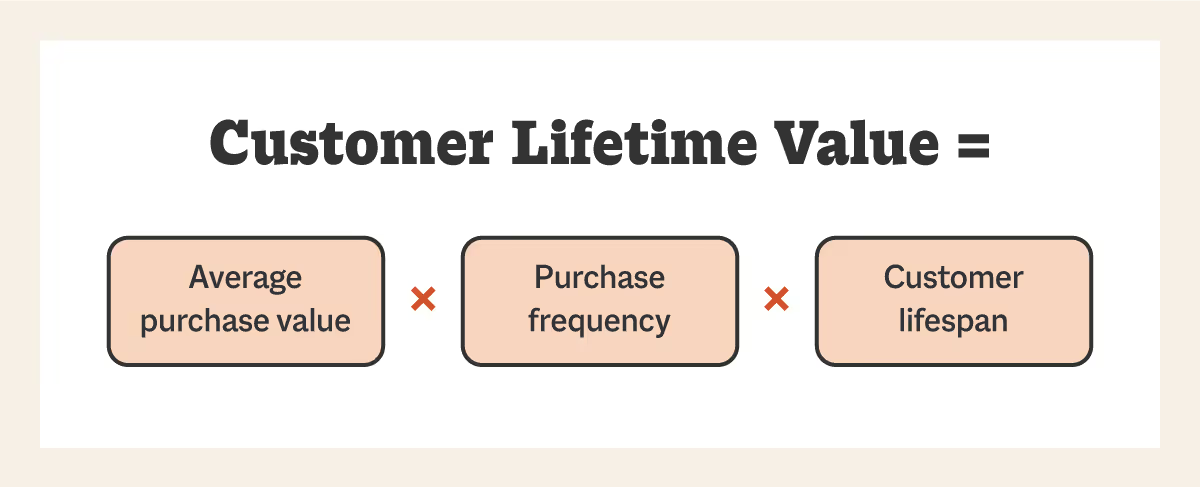
5. Lead response time
Your lead response time evaluates your sales team's effectiveness when responding to inquiries.
What it measures: the time it takes for a sales team or rep to respond to a lead or prospect inquiry
Why it’s important: Lead response time directly impacts customer experience, lead conversion rates, and overall sales effectiveness.
“Today, cost-effective and sustainable growth is more important than ever and speed-to-lead is critical to making that happen. A quick and timely response to leads can significantly increase the chances of converting them into customers. On the other hand, delayed or slow responses may result in missed opportunities, decreased customer satisfaction, and loss of revenue.” - Rick Hespenheide, Head of Outreach Smith.ai

6. Average deal size
Calculating the average deal size allows you to better understand your revenue streams and evaluate your sales performance.
What it measures: the average value of each sale, helping businesses understand how much money they earn from each transaction on average
Why it’s important: By monitoring changes in the average deal size over time, you can identify trends and make necessary adjustments to your strategies. This sales KPI also helps in forecasting and planning by estimating the revenue generated per sale. Understanding this metric is crucial for establishing sales targets, managing staff and resources, evaluating pricing strategies, and pinpointing opportunities to enhance the value of each sale.
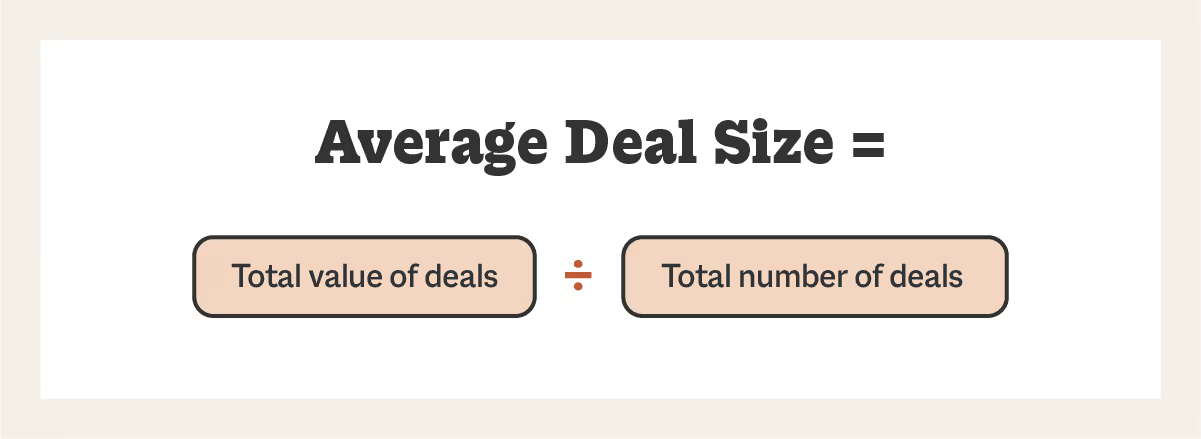
7. Monthly sales bookings
Monthly sales bookings are an important sales KPI because it offers insight into your sales pipeline and expected revenue for upcoming months.
What it measures: the total value of sales orders or contracts that have been booked or confirmed during a specific month
Why it’s important: Monitoring this metric helps assess sales health, forecast cash flow, and allocate resources appropriately. Comparing bookings to targets can help identify trends and enable data-driven decisions for improving sales growth.

8. Sales cycle length
Sales cycle length is an essential KPI for sales, as it helps you assess your sales efficiency and effectiveness.
What it measures: the average time it takes for a lead to move from the initial contact or lead generation stage to the final step of closing the sale
Why it’s important: You can gain insights into the average time it takes to convert leads into customers.
“Knowing your prospect’s decision-making process and understanding your sales cycle helps identify bottlenecks so you can look for ways to move more quickly and close more deals. It also helps with setting realistic quotas and timelines, determining staffing needs, and supporting lead nurturing programs — so you know what materials or messaging helps motivate a buyer at just the right time.” - Dom Gomez, Sales Enablement Manager at Smith.ai

9. Rep retention rate
Your rep retention rate can give you some insight into the health of your internal sales team.
What it measures: the percentage of sales representatives a company retains over a specific period
Why it’s important: Monitoring your rep retention rate helps you assess the leadership skills of your sales management team, identify areas for improvement, and implement strategies to enhance employee satisfaction.
“A high rep retention rate can lead to higher sales productivity, better customer relationships, and healthier overall business performance. It’s important to motivate staff to work diligently, while also helping them feel fulfilled and happy in their roles.” - Steve Green, Head of Sales at Smith.ai

10. Customer retention rate
By focusing on customer retention, you can foster long-term customer relationships, drive customer loyalty, and, ultimately, boost your bottom line over time.
What it measures: the percentage of customers a business successfully retains over a specific period
Why it’s important: Monitoring and improving your customer retention rate is crucial, as retaining existing customers is typically more cost-effective than acquiring new ones.
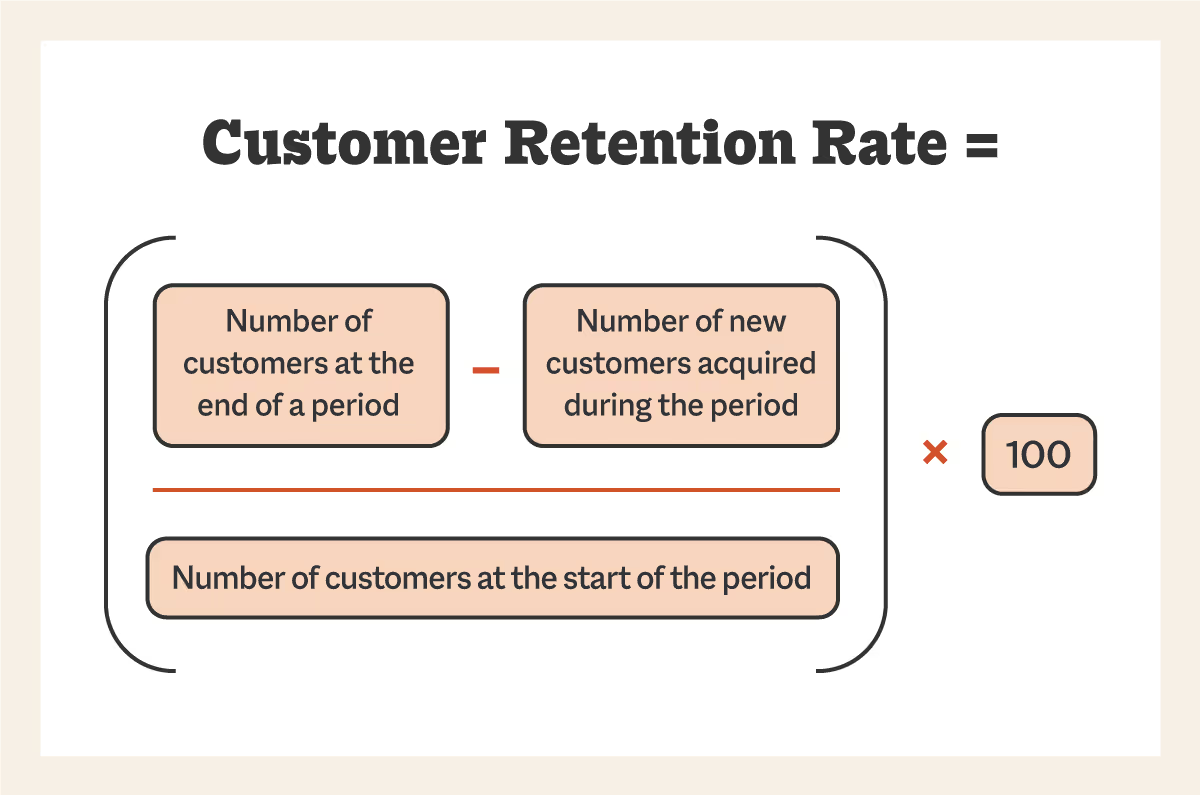
11. Annual contract value (ACV)
ACV helps you assess revenue streams, forecast future revenue, and make informed decisions regarding pricing, customer acquisition, and resource allocation.
What it measures: the average annual revenue or value of a customer's contract or subscription with a business
Why it’s important: ACV is an important metric for subscription-based businesses or those with long-term contracts because it gives you insight into the value of each customer relationship.

12. Sales by source
By analyzing sales by source, you can identify which channels are most successful in driving revenue.
What it measures: the breakdown of sales revenue generated (or co-generated) by different sources or channels through which customers are acquired or transactions are made
Why it’s important: Monitoring sales by source will help you determine the ROI for different marketing initiatives and allocate resources more effectively. Some commonly tracked sources or channels include direct sales, referrals, online ads, social media, email marketing, events, and partnerships.
“By knowing which activities are most fruitful, you can allocate the right funds and resources into the channels that produce the best results. It should be an activity that’s constantly monitored too — so you can be most flexible with your spend and shift when and where it makes sense.” - Tom Armitage, Senior Marketing Manager at Smith.ai

13. Lead-to-opportunity ratio
Your lead-to-opportunity ratio helps you evaluate the quality of your lead generation efforts and your sales team's ability to convert leads into meaningful opportunities.
What it measures: the effectiveness of converting leads into qualified sales opportunities
Why it’s important: Tracking the lead-to-opportunity ratio allows you to identify areas for improvement in lead qualification, nurturing, and sales follow-up processes. It also helps improve the sales playbook used in your discovery meetings andthe ability to identify ideal customers.

14. Opportunity-to-quote ratio
By tracking the opportunity-to-quote ratio, you can identify potential bottlenecks in your sales process.
What it measures: the effectiveness of converting sales opportunities into formal quotes or proposals
Why it’s important: This KPI provides insights into the effectiveness of lead qualification, sales strategies, and quote generation practices. This information enables you to optimize your sales efforts, improve quote accuracy and turnaround time, and make informed decisions about sales pipeline management and resource allocation.
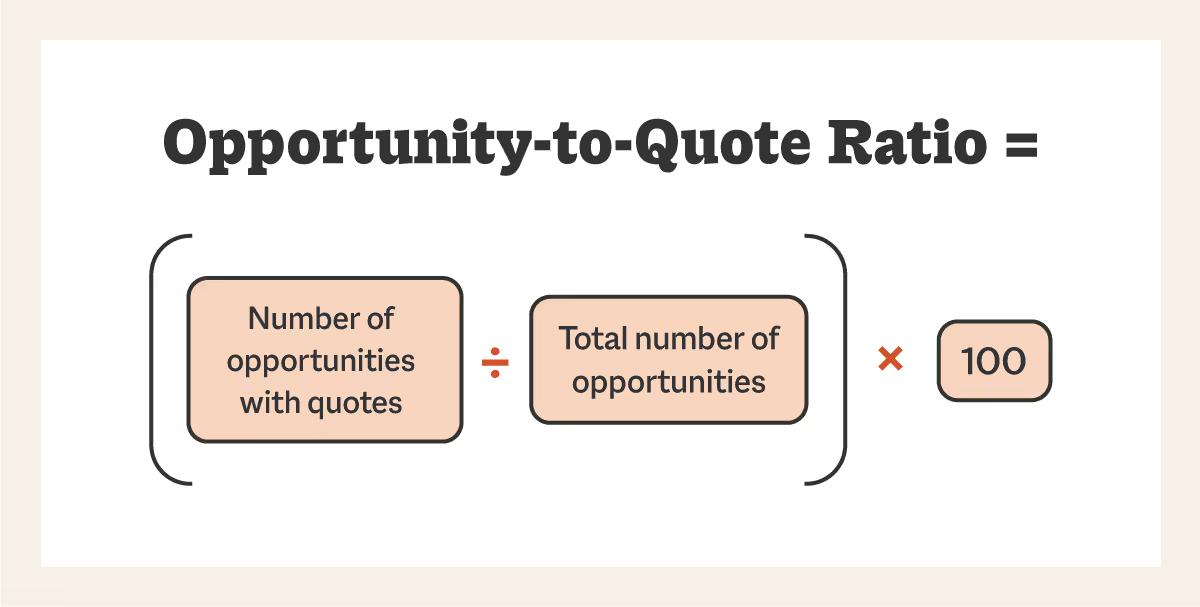
15. Quote-to-close ratio
Tracking the quote-to-close ratio can help you evaluate the effectiveness of your proposal quality, pricing accuracy, and negotiation tactics.
What it measures: the effectiveness of converting quotes or proposals into closed sales
Why it’s important: The quote-to-close ratio provides insights into the strengths and weaknesses of your sales process, enabling you to identify areas for improvement, refine quoting practices, and make informed decisions regarding pricing strategies, sales team training, and resource allocation.

Exceed your KPIs by outsourcing to Smith.ai
Tracking KPIs in sales enables you to measure your success, make informed decisions, align your sales efforts with overall objectives, and drive sustainable growth.
If you're struggling to meet your KPIs or aiming to surpass them, consider leveraging our 24/7 live agents as your outreach team. Our sales agents are equipped to make calls on your business's behalf and utilize customized AI-driven workflows to optimize results and set appointments.
To learn more about how Smith.ai can help your business grow, book a free consultation.
Take the faster path to growth. Get Smith.ai today.
Key Areas to Explore
Technical Implementation Terms
Voice user interface (VUl) design
Speech recognition integration
Text-to-speech optimization
API connectivity and webhooks
Real-time data synchronization

Your submission has been received!














.svg)



